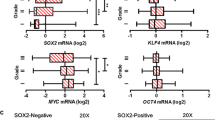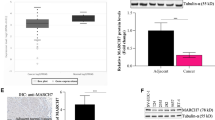Abstract
Wnt/β-catenin signaling pathway modulates miscellaneous biological events in cells including gene expression, cell growth, apoptosis, metabolism and transition. The aim of this study was to investigate the effect of endostatin on Wnt signaling pathway of stem-like cells in bladder cancer in tumor microenvironment. The qRT-PCR assay and western blot were conducted to evaluate related factors expressions of Wnt signaling pathway in both bladder cancer 5637 cells and stem cells. Loss of function assays were carried out to detect the influence of endostatin on the proliferation, migration, cell proliferation and apoptosis of bladder cancer cells. We demonstrated that endostatin triggered the degradation of β-catenin, a key mediator of Wnt signaling. The activation of the endostatin blocked β-catenin function and inhibited cell growth and migration of bladder cancer. In order to verify that the Wnt/β-catenin signaling pathway was inhibited by endostain in 5637 bladder cancer cells and stem cells, the Wnt/β-catenin signaling pathway-associated molecules, including DKK1, LRP5, TCF4, β-catenin, cyclin D1, and c-Myc, were evaluated in 5637 bladder cancer cells and stem cells. The western blotting results showed that expressions of these molecules were remarkably increased in the 5637 bladder cancer cells and stem cells compared to the control group. In summary, our study demonstrated that endostatin inhibited angiogenesis. The downregulation of the Wnt/β-catenin pathway may be engaged in the suppression of angiogenesis by endostatin in bladder cancer cells and cancer stem cells.






Similar content being viewed by others
Data availability
All data generated or analyzed during this study are included in this article.
References
Bladder cancer: diagnosis and management of bladder cancer: © NICE (2015) bladder cancer: diagnosis and management of bladder cancer (2017). BJU Int 120:755–765
Bateni ZH, Pearce SM, Zainfeld D et al (2018) National practice patterns and overall survival after adjuvant radiotherapy following radical cystectomy for urothelial bladder cancer in the USA, 2004–2013. Eur Urol Oncol 3:1. https://doi.org/10.1016/j.euo.2018.11.010
Tabayoyong W, Kamat AM (2018) Current use and promise of urinary markers for urothelial cancer. Curr Urol Rep 19:96
Kato D, Kawase M, Ishida T et al (2019) Investigation of clinical outcome and prognosis of 2nd TUR-Bt for T1 high grade bladder cancer. Hinyokika Kiyo 65:105–109
Kuroiwa K, Inokuchi J, Nishiyama H et al (2019) Impact of previous, simultaneous or subsequent bladder cancer on prognosis after radical nephroureterectomy for upper urinary tract urothelial carcinoma. J Urol 3:1. https://doi.org/10.1097/JU0000000000000422
Schaffar R, Pant S, Bouchardy C et al (2019) Testicular cancer in Geneva, Switzerland, 1970–2012: incidence trends, survival and risk of second cancer. BMC Urol 19:64
Wu D, Lin J, Zhu Y et al (2019) Expression of testis-specific gene antigen 10 (TSGA10) is associated with apoptosis and cell migration in bladder cancer cells and tumor stage and overall survival in patients with bladder cancer. Med Sci Monit 25:5289–5298
Kamat AM, Bellmunt J, Galsky MD et al (2017) Society for Immunotherapy of Cancer Consensus Statement on immunotherapy for the treatment of bladder carcinoma. J Immunother Cancer 5:68
Boegemann M, Aydin AM, Bagrodia A et al (2017) Prospects and progress of immunotherapy for bladder cancer. Expert Opin Biol Ther 17:1417–1431
Kim TJ, Moon HW, Kang S et al (2019) Urovysion FISH could be effective and useful method to confirm the identity of cultured circulating tumor cells from bladder cancer patients. J Cancer 10:3259–3266
Shi X, Chen S, Zhang Y et al (2019) Norcantharidin inhibits the DDR of bladder cancer stem-like cells through cdc6 degradation. Onco Targets Ther 12:4403–4413
Shibata M, Hoque MO (2019) Targeting cancer stem cells: a strategy for effective eradication of cancer. Cancers (Basel) 11:732
Sun X, Song J, Li E et al (2019) (−)-Epigallocatechin3gallate inhibits bladder cancer stem cells via suppression of sonic hedgehog pathway. Oncol Rep 42:425–435
Mao W, Kong J, Dai J et al (2010) Evaluation of recombinant endostatin in the treatment of atherosclerotic plaques and neovascularization in rabbits. J Zhejiang Univ Sci B 11:599–607
Liu CN, Zhang HY, Liu CL et al (2019) Upregulation of lncRNA CALML3-AS1 promotes cell proliferation and metastasis in cervical cancer via activation of the Wnt/beta-catenin pathway. Eur Rev Med Pharmacol Sci 23:5611–5620
Luo Y, Barrios-Rodiles M, Gupta GD et al (2019) Atypical function of a centrosomal module in WNT signalling drives contextual cancer cell motility. Nat Commun 10:2356
Tang XL, Luo H, Zhou H et al (2019) Higher expression of Linc00152 promotes bladder cancer proliferation and metastasis by activating the Wnt/beta-catenin signaling pathway. Med Sci Monit 25:3221–3230
Gao L, Xu FM, Shi WJ et al (2018) High-glucose promotes proliferation of human bladder cancer T24 cells by activating Wnt/beta-catenin signaling pathway. Eur Rev Med Pharmacol Sci 22:8151–8160
Jing J, Liu J, Wang Y et al (2019) The role of ZBTB38 in promoting migration and invasive growth of bladder cancer cells. Oncol Rep 41:1980–1990
Luo J, Lou Z, Zheng J (2019) Targeted regulation by ROCK2 on bladder carcinoma via Wnt signaling under hypoxia. Cancer Biomark 24:109–116
Xu H, Huang Z, Li Y et al (2019) Perioperative rh-endostatin with chemotherapy improves the survival of conventional osteosarcoma patients: a prospective non-randomized controlled study. Cancer Biol Med 16:166–172
Zhu SB, Huang JL, Pan JH et al (2019) Evaluation of tumor vascular normalization in colorectal cancer mouse mode induced by recombinant human endostatin by intravoxel incoherent motion diffusion-weighted magnetic resonance imaging. Zhonghua Zhong Liu Za Zhi 41:421–428
Szarvas T, László V, Vom Dorp F et al (2012) Serum endostatin levels correlate with enhanced extracellular matrix degradation and poor patients’ prognosis in bladder cancer. Int J Cancer 130:2922–2929
Gao P, Gao YJ, Liang HL (2015) Effect of NF-kappa B inhibitor PDTC on VEGF and endostatin expression of mice with Lewis lung cancer. Asian–Pac J Trop Med 8:220–224
Gao SR, Li LM, Xia HP et al (2015) Clinical observation on recombinant human endostatin combined with chemotherapy for advanced gastrointestinal cancer. Asian–Pac J Cancer Prev 16:4037–4040
Wang S, Lu XA, Liu P et al (2015) Endostatin has ATPase activity, which mediates its antiangiogenic and antitumor activities. Mol Cancer Ther 14:1192–1201
Wang Z, Li Z, Wang Y et al (2015) Versican silencing improves the antitumor efficacy of endostatin by alleviating its induced inflammatory and immunosuppressive changes in the tumor microenvironment. Oncol Rep 33:2981–2991
Xu X, Mao W, Chen Q et al (2014) Endostar, a modified recombinant human endostatin, suppresses angiogenesis through inhibition of Wnt/β-catenin signaling pathway. PLoS ONE 9:e107463
Song Y, Liu G, Liu S et al (2019) Helicobacter pylori upregulates TRPC6 via Wnt/beta-catenin signaling to promote gastric cancer migration and invasion. Onco Targets Ther 12:5269–5279
Vallee A, Lecarpentier Y, Vallee JN (2019) Targeting the canonical WNT/beta-catenin pathway in cancer treatment using non-steroidal anti-inflammatory drugs. Cells 8:726
Kalita B, Ranjan R, Gupta ML (2019) Combination treatment of podophyllotoxin and rutin promotes mouse Lgr5(+ ve) intestinal stem cells survival against lethal radiation injury through Wnt signaling. Apoptosis 24:326–340
Mathieu J, Detraux D, Kuppers D et al (2019) Folliculin regulates mTORC1/2 and WNT pathways in early human pluripotency. Nat Commun 10:632
Zhang X, Liu R, Zhao N et al (2019) Sohlh2 inhibits breast cancer cell proliferation by suppressing Wnt/beta-catenin signaling pathway. Mol Carcinog 58:1008–1018
Funding
This work was supported by City of Nanchong Strategic Cooperation with Local Universities Foundation of Technology (NSMC20170421, NSMC20170111, 18SXHZ0581, 18SXHZ0128).
Author information
Authors and Affiliations
Corresponding author
Ethics declarations
Conflict of interest
None declared.
Additional information
Publisher's Note
Springer Nature remains neutral with regard to jurisdictional claims in published maps and institutional affiliations.
Rights and permissions
About this article
Cite this article
Wu, T., Duan, X., Hu, T. et al. Effect of endostatin on Wnt pathway of stem-like cells in bladder cancer in tumor microenvironment. Mol Biol Rep 47, 3937–3948 (2020). https://doi.org/10.1007/s11033-020-05487-3
Received:
Accepted:
Published:
Issue Date:
DOI: https://doi.org/10.1007/s11033-020-05487-3




